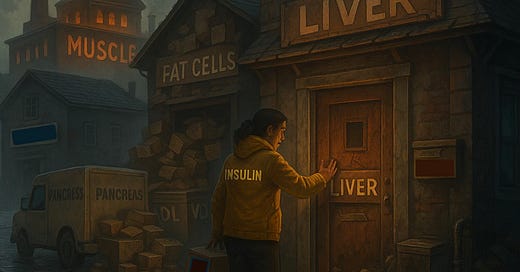Before It Becomes Diabetes, Here’s What Fails First—and How to Stop It.
It starts with one message getting lost in translation—and ends in a full-body metabolic meltdown.
If insulin were a person, she’d be the world’s most under appreciated coordinator.
She’s polite. Efficient. Always shows up on time.
Her job?
She walks nutrients—especially sugar—into your cells after you eat. She knocks on the door and says, “Hey, here’s some energy. Use it.”
But one day, the doors stop opening.
Not because she’s doing anything wrong.
But because the cells have stopped listening.
This is insulin resistance.
And when your body stops listening, everything—everything—starts falling apart.
Let’s say your body is a neighborhood.
Each house is an organ:
The liver is the city planner.
Muscle is the power plant.
The brain runs the library and city council.
The fat cells are the storage units.
And the pancreas is the overworked delivery guy—bringing insulin to every door.
At first, the system runs smoothly. You eat. Insulin arrives with sugar in hand. The doors open. Fuel gets in. Energy is made.
But slowly, without warning, the doors stop responding.
The locks get rusty. The hinges freeze.
And insulin’s polite knock? Ignored.
So what does she do?
She knocks louder.
The pancreas sends more insulin.
Still no answer.
And now? The sugar just... sits outside.
Floating through the bloodstream.
Causing trouble wherever it goes.
Let’s walk through that neighborhood now.
Because the damage isn’t random.
It’s systematic.
The Fat Cells Overflow
Fat cells aren’t just storage lockers—they’re chemical factories.
When they’re healthy, they tuck away excess energy quietly.
But when they stop listening to insulin, they become hoarders.
They leak fat back into the bloodstream.
Now, instead of being stored safely, this fat floats around like loose debris.
It clogs up other systems. Inflammation rises.
It’s like a spark in a dry forest.
The fat cells start shouting inflammatory messages: “We’re full! We’re inflamed! We’re out of control!”
And those messages don’t stay local—they spread.
The Liver Gets Jammed
The liver’s job is to regulate energy and clean up metabolic waste. But now it's being flooded with extra fat.
To manage the load, it turns the fat into little particles called VLDL—very-low-density lipoproteins—and ships them into your bloodstream.
What’s VLDL? Think of it like greasy packaging: it's how the liver tries to offload extra fat.
But those packages float around, clogging arteries, raising your cholesterol, and setting the stage for heart disease.
The liver itself gets fatty too. That’s called fatty liver disease—and no, you don’t need to drink alcohol to get it.
The Heart Starts to Panic
Now that there’s more fat and sugar floating in the blood, the heart’s workload increases.
Insulin used to help blood vessels relax.
But with resistance? Blood vessels stay stiff. The pressure rises.
The blood thickens. Clots form more easily.
This is a perfect storm for heart attacks and strokes.
Not because your heart failed.
But because the message of insulin failed to get through.
The Muscles Shut Their Doors
Muscles are one of insulin’s favorite stops.
They use a lot of energy—especially after you move.
But now they’re ignoring insulin too.
Sugar can’t get inside.
Your muscles grow weak. Tired. Sluggish.
And that extra sugar? It goes back into circulation, feeding the chaos.
You might feel this as low energy, brain fog, or a weird “hangry” sensation after eating.
The Brain Goes Foggy
Insulin helps your brain focus, process, and store memories.
But with insulin resistance, the brain can’t use fuel properly.
Processing speed slows.
Focus fades.
Memory suffers.
Over time, this fog isn’t just annoying—it’s dangerous.
Studies now link midlife insulin resistance to a higher risk of Alzheimer’s disease.
They even call Alzheimer’s “type 3 diabetes” in some research circles.
The Kidneys Swell
As insulin levels rise, kidneys start hoarding salt.
More salt means more water. More water means higher blood pressure.
This isn’t a plumbing issue—it’s a communication breakdown.
Insulin is supposed to be a whisper. Now it’s shouting.
And the kidneys are getting overwhelmed.
The Pancreas Burns Out
Remember that delivery guy—insulin’s producer?
He’s been working overtime.
Trying to compensate.
Flooding the system with more insulin to get the same response.
This overproduction has a name: hyperinsulinemia—too much insulin in the blood.
At first, it works.
But over time, it burns the system out.
The pancreas can’t keep up.
And when it fails? That’s when type 2 diabetes officially shows up.
But the damage has been happening long before the diagnosis.
Are You Insulin Resistant?
Here’s a simple way to find out—and what to do about it.
Wondering if you’re insulin resistant? Here’s how to find out—and what to do about it.
To access the full protocol, including:
The formula and how to use it
What your numbers actually mean
The 7-step Habit Healers plan to reverse insulin resistance
A simple weekly tracker to help you stay consistent
Upgrade to a paid subscription to unlock the full guide.
This next section is available exclusively to Inner Circle members, because healing doesn’t happen with more information alone. It happens when you apply the right habits, in the right order, with the right support.
If you’re ready to stop guessing and start healing, join us now.
You’re not behind. You’re just one healing habit away.
Upgrade now for full access.





